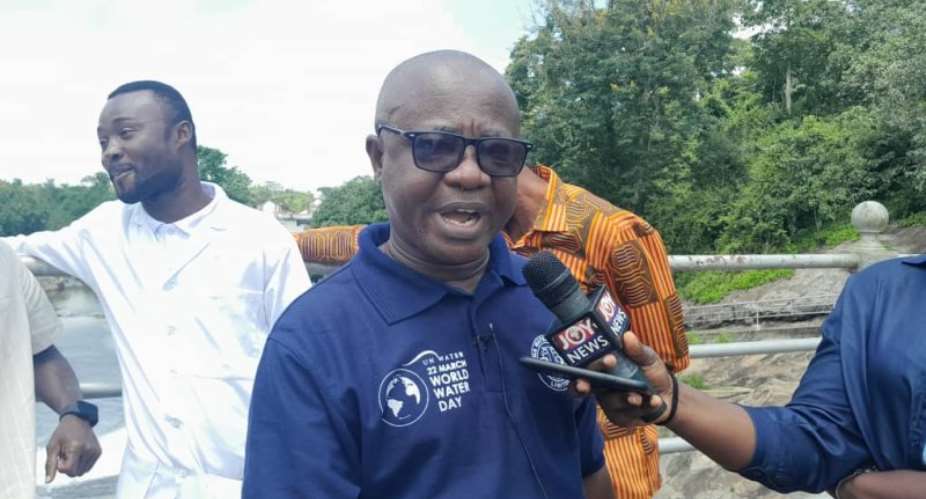The Ghana Water Company Limited (GWCL) in the Central Region has flatly denied complicity in the recent flood disaster that devastated scores of communities in the Komenda-Edina-Eguafo-Abirem Municipality and its environs and destroyed the Jukwa- Cape Coast main road, rendering commuters stranded.
On Saturday, June 18, there were massive floods in parts of the Central Region and residents largely blamed the GWCL for spilling excess water from its Brimsu dam without prior notice.
However, the company on a media tour of its New Brimsu Waterworks facility on Monday, July 18, refuted any involvement in the flood waters, indicating that the dam did not have spill gates.
Nana Yaw Barima Barnie, the Western and Central Regional Communications Manager of the company, told journalists that instead, there was a sudden overflow of the dam between June 17 and June 18 which resulted in the third highest flood incident in the area after July 1955 and June 1979.
He said the incident took them by surprise because there were no indications that the water would run-off, for which reason they could not warn residents in its catchment areas.
That Notwithstanding, he maintained that the overflow of the dam was not the cause of the devastations at Jukwa and adjoining communities because they are situated upstream the dam.
“Water does not flow in the reverse direction and therefore whatever excess water that goes out of this dam cannot go to Jukwa Road and destroy it and so that allegation that Ghana Water Company was complicit in what happened on the Jukwa road is something we should put to rest,” he said.
Nana Barnie intimated that the cause of the sudden overflow of the dam was yet to be established but suspected that it might have rained heavily elsewhere.
He noted that GWCL had always cautioned residents in catchment areas ahead of massive spillovers, insisting that it was not a case of negligence on their part.
The Brimsu dam was constructed in 1928 and had undergone several interventions over the years to increase its capacity.
Unlike the Weija Dam in Accra, the dam was not designed to have a spill gate.
It naturally overflows at 19 feet and could cause flooding in adjoining communities when the water levels hit 32 feet.
The dam was overflowing when the team got to the site.
Being the second biggest water treatment plant in the Central Region after Kwanyako, the New Brimsu water treatment plant which sources raw water from the Kakum River, is able to produce 8.5 million gallons of treated water per day.
Mr Barnie said to mitigate the impact of flooding in adjoining communities and check the incidents of occasional water rationing, the company would start considering the option of constructing an installation to hold excess water.
He further observed that the treatment plant did not face any issues with polluted water as the Kakum River was free of galamsey and other notorious activities.
Mr George Buddy, the Station Manager who led the team on the tour, said the interest of surrounding communities was paramount to the company and would therefore not act to jeopardise their lives in any way.
“It happened overnight and there was nothing we could do about it; we could not control it,” he said.
Explaining why some communities in Cape Coast were still facing water crisis, he noted the consumption levels had outstripped the capacity of the treatment plant, adding that the capacity needed to be expanded.
GNA





 We’ll protect state wealth from opaque deals – Prof Jane Naana
We’ll protect state wealth from opaque deals – Prof Jane Naana
 Mauritania president says running for second term in June polls
Mauritania president says running for second term in June polls
 I won't ever say I was a mere driver’s mate' — Prof. Opoku-Agyemang
I won't ever say I was a mere driver’s mate' — Prof. Opoku-Agyemang
 2024 polls: 'EC struggling to defend credibility'— Prof. Opoku-Agyemang
2024 polls: 'EC struggling to defend credibility'— Prof. Opoku-Agyemang
 Akufo-Addo gov't's 'greed, unbridled arrogance, unrestrained impunity, sheer dis...
Akufo-Addo gov't's 'greed, unbridled arrogance, unrestrained impunity, sheer dis...
 Election 2024: Ghana needs an urgent reset, a leadership that is inspiring – Ma...
Election 2024: Ghana needs an urgent reset, a leadership that is inspiring – Ma...
 Partner NDC to rollout a future of limitless prospects – Prof Jane Naana Opoku-A...
Partner NDC to rollout a future of limitless prospects – Prof Jane Naana Opoku-A...
 NPP will remain in gov’t till Jesus comes — Diana Asamoah
NPP will remain in gov’t till Jesus comes — Diana Asamoah
 Sunyani Technical University demands apology from former SRC president over sex-...
Sunyani Technical University demands apology from former SRC president over sex-...
 'Dumsor' was resolved by Mahama but ‘incompetent' Akufo-Addo has destroyed the g...
'Dumsor' was resolved by Mahama but ‘incompetent' Akufo-Addo has destroyed the g...
